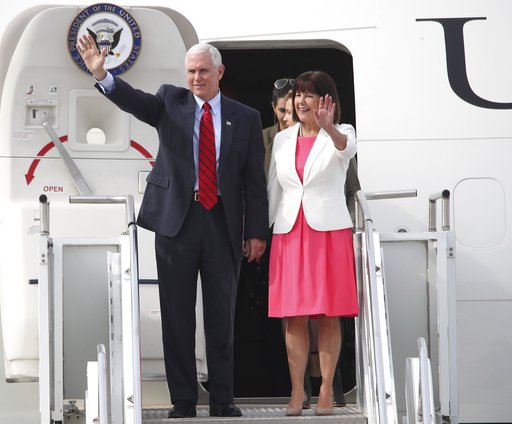
U.S. Vice President Mike Pence and his wife Karen wave upon their arrival at Osan Air Base in Pyeongtaek, South Korea, Sunday, April 16, 2017. Pence arrived in South Korea on Sunday to begin a 10-day trip to Asia that comes amid turmoil on the Korean Peninsula over North Korea’s threats to advance its nuclear and defense capabilities, and just after a failed missile launch by the North. (Kim Do-hoon/Yonhap via AP)
SEOUL, South Korea — U.S. Vice President Mike Pence arrived in South Korea on Sunday to begin a 10-day trip to Asia that comes amid turmoil on the Korean Peninsula over North Korea’s threats to advance its nuclear and defense capabilities, and just after a failed missile launch by the North.
Pence arrived in the region a day after North Korea celebrated the birth anniversary of the country’s late founder with a military parade showing off missiles and military hardware.
A North Korean missile exploded during launch Sunday, U.S. and South Korean officials said, a high-profile failure that comes as a powerful U.S. aircraft supercarrier approaches the Korean Peninsula in a show of force.
Pence, joined by his wife, Karen, placed a wreath at Seoul National Cemetery during a brief ceremony. He was expected to join U.S. and South Korean troops for Easter Sunday church services and a dinner later in the day.
President Donald Trump has suggested that the U.S. will take a tougher stance against North Korea, telling reporters last week: “North Korea is a problem. The problem will be taken care of.” He has repeatedly said if China, North Korea’s dominant trading partner, is unwilling to do more to pressure the North, the U.S. might take the matter into its own hands.
Along with the deployment of the Naval aircraft carrier and other vessels into waters off the Korean Peninsula, thousands of U.S. and South Korean troops, tanks and other weaponry were also deployed last month in their biggest-ever joint military exercises. That led North Korea to issue routine threats of attacks on its rivals if they show signs of aggression.
Despite North Korea’s provocations, U.S. officials have said that the U.S. doesn’t intend to use military force against North Korea in response to either a nuclear test or a missile launch.
After a two-month policy review, officials settled on a policy dubbed “maximum pressure and engagement,” U.S. officials said Friday. The administration’s immediate emphasis, the officials said, will be on increasing pressure on Pyongyang with the help of Beijing.
The officials weren’t authorized to speak publicly on the results of the policy review and requested anonymity.
Pence will be tasked with explaining the policy in meetings with leaders in South Korea and Japan at the start of his trip, which will also include stops in Indonesia and Australia. He will also aim to reassure allies in South Korea and Japan that the U.S. will take appropriate steps to defend them against North Korean aggression.
Pence’s first trip to South Korea will carry personal meaning as well. His late father, Edward, served in the U.S. Army during the Korean War and was awarded the Bronze Star on April 15, 1953 — 64 years to the day of the vice president’s departure for South Korea. Pence displays in his office his father’s Bronze Star and a photograph of his father receiving the honor./rga